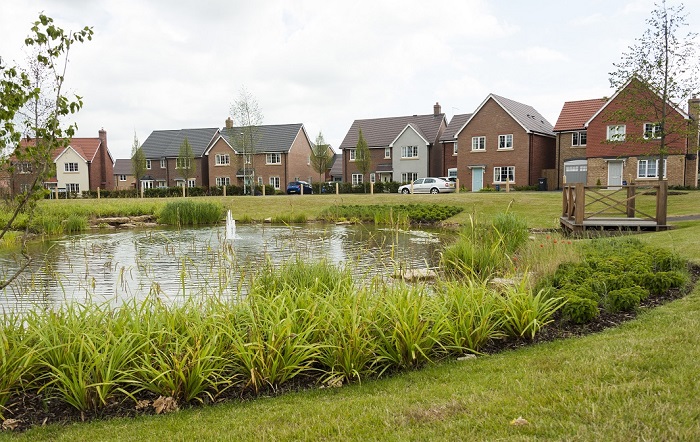
The UK housing crisis is well-documented, but what measures are in place – or planned – to ease the problem?
In the following article, we overview the impact of Garden Villages, including regional implications, what the result might be for new buyers, and potential follow on trends.
What is a garden village?
By definition it is a piece of brownfield land that is used to develop new areas for families and businesses. They are usually smaller projects and can contain from 1,500 to 10,000 homes. Often, garden villages have their own facilities — such as schools, shops and transport stations — which makes this type of living space perfect for families and first-time buyers looking to lead the picture-perfect life.
Garden villages allow residents to imprint their own mark on the area, including creating its own identity and creating rules. However, there are a few ways to identify them. They must be a settlement outside of an existing town or city and not closely attached. The British government is currently supporting 17 locations around the country, with £6 million expected to go towards funding 14 new garden villages and £1.4 million to support three garden towns (which are similar to garden villages, only larger).
Current/prospective garden villages in the UK:
- Cumbria
- Lancaster
- Cheshire East
- Merseyside
- Derbyshire
- Lincolnshire
- Stratford-on-Avon
- East Northants
- Oxfordshire
- Essex
- Devon
- Runnymede
- Surrey Heath
- Hampshire
- Cornwall
Plans are also in place to build garden towns in Aylesbury, Taunton and Harlow, and Gilston. These towns are anticipated to provide an extra 200,000 homes.
The potential effect on UK regions:
Regions are set to see more manual work available in these regions as such areas will be creating more than 50,000 homes. This will help to boost the economy, as it will provide people with more jobs in the area.
As new homes are built, people will be buying them — this potentially means more residents within the region. There is a popular misconception that this will put a strain on the resources of current residents nearby, such as school places for their children and obtaining doctor appointments. However, this is not the case, as garden villages are built with their own facilities including schools and general practices. In turn, this will also create more jobs in the area of development.
However, it’s important to remember that these locations usually have their own transport links. On the other hand, more cars on the road could cause congestion.
Taking a look at some follow-on trends
Although there will be plenty of communal green space to explore for new residents, homes will still have their own gardens for homeowners to enjoy. But what are the current outdoor space trends?
Many homeowners are beginning to invest in composite decking. With the UK weather constantly variable, composite decking boards are weather-resistant and very low maintenance, which means you don’t need to worry about repairing or repainting.
Over the past few years, more people are purchasing hot tubs for their gardens. In North Wales, a businessman has even had to double the size of his hot tub showroom this year to keep up with demand! These are a great addition to any garden, especially if you have a rural view of the surrounding countryside.
According to Andrew Hartley, research director at market research company, AMA; garden buildings including sunhouses have “high potential growth” in the industry. Sunhouses are great for maximising your garden space and creating an extra room for your family without having to pay for an expensive house extension. Typically, these are small and easy to fit into your garden with enough room for a few chairs and a table to unwind with drinks and food. Sunhouses infuse your garden with character and are excellent refuges for reading, relaxing and socialising, so these are ideal for new garden village homes.
Artificial grass is becoming a bigger trend too. Slashing the time we have to spend maintaining our outdoor spaces and beautiful to look at from season to season, fake grass is a high-demand gardening commodity. If you’ve decked much of your back garden, you can add colour by creating a small space of artificial grass on the ground level, or putting a full artificial lawn at the front of your home that you don’t have to keep weeding and watering.
Ambience in your garden is everything. From hanging Chinese lanterns between decking posts to placing LED fairy lights into vintage jam jars, how you illuminate your garden is going to be in focus. Speaking of vintage, garden furniture is set to head back in time when it comes to design and textures. We’ll see more natural, traditional materials used for tables and chairs — such as teak and rattan — to create a more rustic look, as well as a rise in woven and crochet techniques for the retro effect. Needless to say, garden village homeowners will have a lot of inspiration for their green spaces.
Undeniably, the development of garden villages could ease pressure on the housing crisis. Even with the few points for concern, such as a rise in local traffic, this is potentially a huge boost for families, communities, as well as the UK economy.
Source:
http://www.dailymail.co.uk/property/article-4087946/What-garden-village-welcome-one-nearby.html
https://www.thesun.co.uk/news/2517967/garden-villages-towns-what-where-why/
https://www.insidermedia.com/insider/wales/hot-tub-company-doubles-in-size-with-new-showroom
https://www.chesneys.co.uk/outdoor/heat-collection/the-heat-collection-of-barbecue-heaters/heat-500
